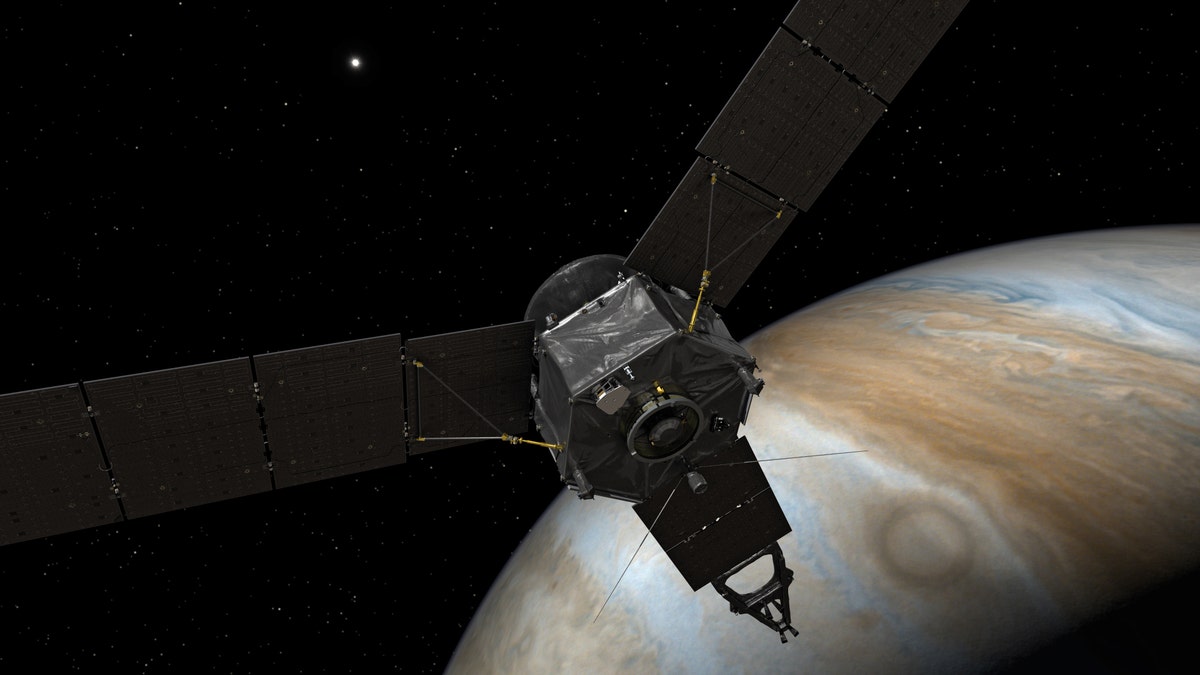
Artist's impression of NASA' s Juno spacecraft at Jupiter (NASA/JPL-Caltech)
NASA’s Juno spacecraft will make history Monday when it flies over Jupiter’s famous Great Red Spot.
The Spot is a 10,000-mile wide storm that has been monitored since 1830, according to NASA. Juno’s flyby will be humanity’s closest look at the huge feature. The spacecraft entered Jupiter’s orbit on July 4, 2016.
"Jupiter's mysterious Great Red Spot is probably the best-known feature of Jupiter," said Scott Bolton, principal investigator of Juno from the Southwest Research Institute in San Antonio, in a statement. "This monumental storm has raged on the solar system's biggest planet for centuries. Now, Juno and her cloud-penetrating science instruments will dive in to see how deep the roots of this storm go, and help us understand how this giant storm works and what makes it so special."
NASA'S NEWEST PHOTO OF JUPITER WILL BLOW YOUR MIND
Juno is expected to reach the point in its orbit closest to Jupiter’s center at 9:55 p.m. EDT Monday, at which time it will be about approximately 2,200 miles above the planet’s cloud tops. Some 11 minutes and 33 seconds later, the spacecraft will be over the vast storm, passing 5,600 miles over the Red Spot’s cloud tops.
A spokeswoman for NASA told Fox News that raw images of Great Red Spot taken by the spacecraft’s JunoCam are expected to be downlinked and available approximately Friday July 14.
Juno celebrated its one-year-anniversary within Jupiter’s orbit at 10:30 p.m. EDT on July 4, 2017, chalking up around 71 million miles in orbit around the gas giant. The spacecraft has come as close as 2,100 miles of Jupiter’s cloud tops during its flybys of the huge planet.
NASA'S JUNO SPACECRAFT ENTERS JUPITER’S ORBIT
Juno launched from Cape Canaveral on Aug. 5, 2011. Early science results from the mission portray Jupiter “as a turbulent world, with an intriguingly complex interior structure, energetic polar aurora, and huge polar cyclones,” according to NASA.
Jupiter is mostly composed of hydrogen and helium surrounding a core of rocks and ice, according to Space.com.
In recent years observations by the Hubble Space Telescope have revealed that the storm in Jupiter’s atmosphere is shrinking.
NASA'S JUNO PROBE NOW ORBITING GAS GIANT JUPITER
In 2015 NASA’s New Horizons spacecraft made a historic flyby of Pluto after traveling 3 billion miles on an epic journey that lasted more than nine years.
The Associated Press contributed to this report.
Follow James Rogers on Twitter @jamesjrogers
